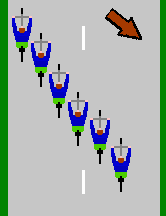Edge of wind
In cycling - technical jargon, a wind edge is a situation of strong crosswinds . Together with the head wind , the wind often blows diagonally from the front (" apparent wind "). This leads to so-called "wind staggering" or other competitive strategies.
Wind edge formation
One strategy in competition is to position yourself offset to the side in the slipstream of the vehicle in front, that is, to form “wind staggered”. They run diagonally across the road in rows of drivers and are limited by the width of the road. The actual wind edge is not the edge of the road, but the area between the road edge and the ditch, which is usually not paved and is unpaved. As a double row in the Belgian roundabout , the number of possible drivers in the group is correspondingly higher.
Due to the lack of space, strong teams who manage to make the leap into the head group have the tactical opportunity to wear down or even distance competing teams outside the head group. This tactical device is also used to push competitors out of the group. This lack of space leads within the wind relay or a roundabout , more positions fights for participation in the leading group are to be expected. As a result, the formation of new wind gauges or gyroscopes that keep pace with the first group can be delayed and a division can be accelerated. Due to the large amount of space required, these competition formations are not allowed in road traffic and are difficult to train. Riders who managed to ride alongside the wind relay were referred to in cycling jargon as "edge riders".
Linguistic
The German language knows the fixed expression “take on the wind edge” with the meaning of intentionally driving on the opposite side of the road to the direction of the wind in order to take away the possibility of the slipstream .
History
In Europe, there are long windsurfing passages, especially in cycling races near the Atlantic coast , i.e. in Belgium, the Netherlands and the north and west of France. An exemplary racing situation on the edge of the wind occurred on the second stage of the Tour de France 2015 with the start in Utrecht shortly before reaching the coast and about 50 kilometers from the Neeltje Jans finish in the Oosterschelde storm surge barrier . This was finally achieved by 24 drivers, including the eventual overall winner Christopher Froome , around one and a half minutes ahead of a group of 65 drivers with a few favorites and around five minutes ahead of the peloton of around 100 drivers. This means that the flat stage was possibly decisive, because it cost Nairo Quintana , who later came second in the second group, more time than his total deficit of 1:12 minutes at the end of the tour.
Individual evidence
- ↑ Explanatory video Eurosport 2016
- ↑ a b c Täves Friedensfahrt-Lexikon . New Germany, Berlin 1965, p. 20 .
- ↑ Handbook for cyclists / author: Achim Schmid , ISBN 3891248172
- ↑ cf. Right-hand drive
- ↑ §2 StVO
- ↑ cf. Greipel cheers by the sea, Nibali and Quintana go swimming. radsport-news.com, May 7, 2015, accessed August 4, 2015 .
